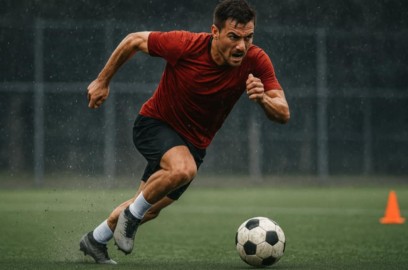
In football, we often associate progress with intensity: fast drills, high-tempo games, nonstop pressing. But there’s a quiet, overlooked method that top players swear by — slow, focused technical training. Repeating key movements at a low pace allows the brain and body to build deep, lasting coordination. It might not look flashy, but it’s a secret weapon that turns talented players into elite performers.
This is how slow training can make you faster, smarter, and more effective in real matches.
SLOW REPEATS = STRONGER NEURAL CONNECTIONS
When you execute a technical movement slowly — like a pass, touch, or turn — you give your brain time to process every part of it. This helps form precise motor patterns that your body can recall later under pressure.
For example:
-
A directional first touch repeated 200 times slowly will build better control than 50 fast reps with mistakes
-
Slow passing sequences help sharpen foot-eye coordination and balance
In matches, this turns into automatic, clean actions – especially when under pressure.
PRECISION BEFORE SPEED
A common mistake among young players is rushing drills to "look intense." But intensity without precision leads to bad habits.
You can't be fast and effective until you’re slow and clean.
Think of how musicians practice. First, slow and perfect. Only then do they increase the tempo.
In football:
-
Practice your turns, feints, and passing sequences in controlled slow tempo
-
Eliminate all unnecessary movements
-
Focus on body positioning, balance, and timing
LOW-INTENSITY = LOW FATIGUE = HIGH FOCUS
During high-speed drills, your body gets tired quickly, and your technical focus drops. Slow training allows you to:
-
Repeat actions longer without physical exhaustion
-
Stay mentally engaged
-
Build confidence through mastery, not just effort
This is especially useful for:
-
Injury recovery phases
-
Individual extra work after team sessions
-
Mornings or rest days when you want to stay sharp
FROM PRACTICE TO GAME: THE TRANSFER
So how does this slow work show up on the field?
You’ll notice:
-
Cleaner first touches in tight spaces
-
Sharper turns under pressure
-
More control when the tempo increases
-
More confidence in 1v1s or when receiving difficult passes
These are the moments where games are won – not by the fastest player, but the most technically composed.
HOW TO STRUCTURE SLOW TECHNICAL SESSIONS
Here’s a sample format for a 20–30 minute solo session:
-
WARM-UP (5 MIN)
Light footwork, mobility, ball mastery without pressure -
PRECISION DRILLS (10 MIN)
-
Directional first touches
-
Inside-outside touches
-
Passing against a wall with both feet
-
Body feints and controlled turns
-
-
SLOW COMBO MOVES (10 MIN)
-
Combine touches + turns
-
1v1 simulation footwork
-
Slow stepovers with weight shift focus
-
-
COOL-DOWN & VISUALIZATION (5 MIN)
-
Mental replay of the movements you want to master
-
Focus on body posture and ball control in your mind
-
FINAL MESSAGE
Slow training is not about being lazy — it’s about being smart.
The calm, focused work you do when no one is watching creates the composure and control that everyone sees on match day.
Train slow to play fast.





